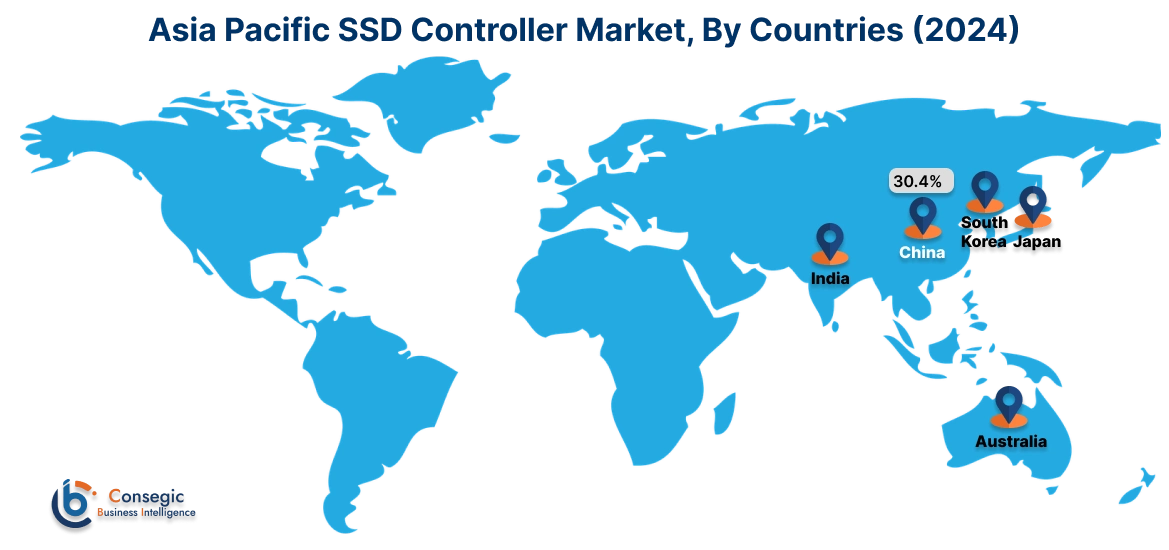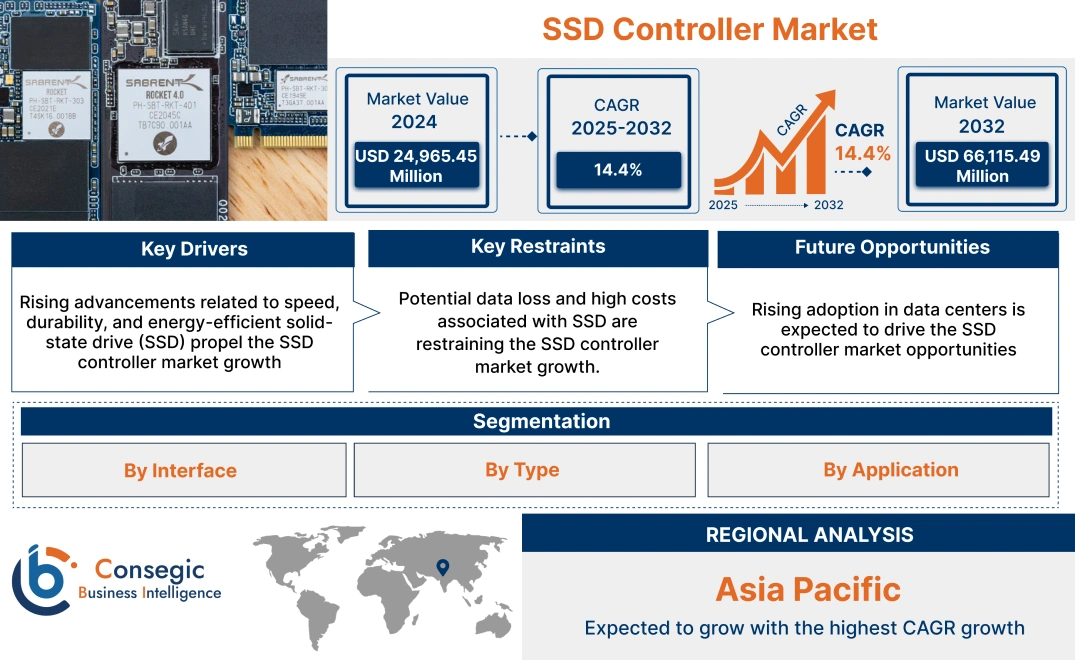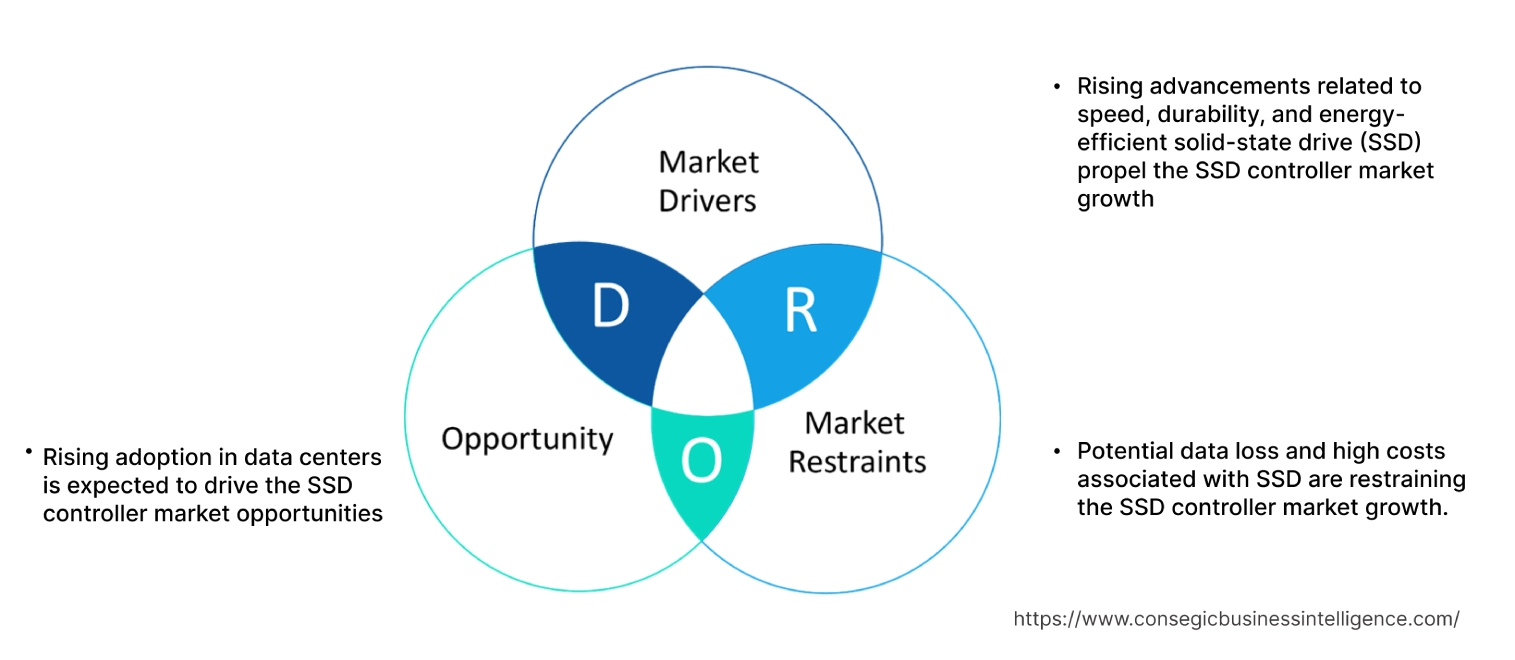- Summary
- Table Of Content
- Methodology
SSD Controller Market Size:
SSD Controller Market size is estimated to reach over USD 66,115.49 Million by 2032 from a value of USD 24,965.45 Million in 2024 and is projected to grow by USD 27,763.08 Million in 2025, growing at a CAGR of 14.4% from 2025 to 2032.
SSD Controller Market Scope & Overview:
SSD controller refers to a type of controller that handles data read & write, error correction, encryption, and wear management. The controller is used for communication with the host and flash. SSD controller also manages functions such as error correction, compression, and encryption through modules. Further, the controller has SRAM, firmware, ROM, and DRAM to help with metadata. Additionally, while choosing an SSD it is important to include factors such as architecture (multi-core, ARM-based), manufacturer, generic controller or custom controller and features such as encryption capabilities and wear leveling.
Key Drivers:
Rising advancements related to speed, durability, and energy-efficient solid-state drive (SSD) propel the SSD controller market growth
Modern solid-state drive storage devices store persistent data on solid-state flash memory in computers and operate similarly to traditional hard drives. Modern SSD controllers improve basic functions such as data transfer rates, read and write operations, and others. Furthermore, solid-state drives have no moving parts that break or spin up and down, enhancing their durability compared to traditional hard drives. Additionally, a solid-state drive contains key components including a NAND flash memory chip and the flash controller for delivering high write and read performance for random and sequential data requests.
- For instance, in September 2024, Samsung Electronics launched 256GB AM9C1, a reliable solid-state drive for automobile applications with improved power efficiency.
Thus, the rising advancements in solid-state drives for improving power efficiency are driving the SSD controller market size.
Key Restraints :
Potential data loss and high costs associated with SSD are restraining the SSD controller market growth.
The utilization of solid state drive is usually associated with high cost. Moreover, solid-state drives have a higher cost per gigabyte and limited storage capacity. Additionally, one of the biggest disadvantages of SSD is the potential permanent data loss due to drive failure, which leads to irreparable consequences. Further, compared to conventional hard disk drives SSDs offer large storage capacity at a higher price, which is a potential restraining factor.
Hence, the potential data loss and high cost associated with solid-state drives are hindering the SSD controller market expansion.
Future Opportunities :
Rising adoption in data centers is expected to drive the SSD controller market opportunities
Datacenter refers to the center that sends and stores data and applications. Moreover, the core components in data centers include storage systems, routers, servers, switches, application-delivery controllers, and security systems. Further, data centers are an integral part of IT enterprise to support various business requirements such as file and email sharing, CRM (Customer Relationship Management), ERP (Enterprise Resource Planning), virtual desktops, and others. Additionally, the data center provides storage infrastructure for holding valuable commodities, network infrastructure that connects virtual as well as physical servers, and computing resources for memory, local storage, and processing.
- For instance, Micron launched 9550 PCIe Gen5 data center SSD innovation by integrating its own NAND, firmware, controller, and DRAM for high-performance storage solutions.
Thus, as per the SSD controller market analysis, the rising adoption of SSD in data centers is driving the global SSD controller market opportunities.
SSD Controller Market Segmental Analysis :
By Interface:
Based on interface, the market is segmented into PCIe, NVMe, SATA, and others.
Trends in the Interface:
- There is an increasing trend toward the adoption of PCIe SSDs due to their various benefits such as improved storage capacity, speed, and compatibility.
- Rising utilization of SATA solid-state drives due to its low cost and wide compatibility across different computers.
SATA accounted for the largest revenue share of the total SSD controller market share in 2024
- SATA (Serial Advanced Technology Attachment) is a technology that connects storage devices such as solid-state drives and hard drives to a computer’s motherboard.
- Moreover, SATA-based solid-state drives have four times more bandwidth compared to spinning disks.
- Additionally, SATA-based solid-state drives are more affordable and widely used in laptops and computers.
- For instance, in October 2023, Swissbit launched SATA solid state drives, X-73, X-75, and X-78, which are powered by 112-layer 3D NAND technology.
- According to the analysis, the rising developments related to SATA-based solid-state drives are driving the SSD controller market size.
PCIe is anticipated to register the fastest CAGR during the forecast period.
- PCIe (Peripheral Component Interconnect Express) solid-state drive is used for attaching a computer to its peripherals for high-speed expansion.
- Moreover, PCIe solid-state drives offer various benefits such as storage capacity, speed, and improved compatibility.
- For instance, in August 2024, Micron launched PCIe Gen6 data center SSD technology to enable an ecosystem of various storage and memory products to support various AI demands.
- According to the analysis, the rising developments related to PCIe-based solid-state drives for enabling the IT ecosystem are driving the SSD controller market.
By Type:
Based on type, the market is segmented into single-level cells, multi-level cells, and triple-level cells.
Trends in the Type:
- There is an increasing trend towards the adoption of multi-level cells due to enhanced data density operation.
- Adoption of triple-level cells is increasing due to its low cost and improved capacity.
Single-level cells accounted for the largest revenue of the overall total SSD controller market share in 2024 and it is anticipated to register a significant CAGR during the forecast period.
- Single-level cell (SLC) is a type of memory cell that is used in flash memory for retrieving and writing data fast.
- Moreover, the single-level cell is used for high endurance applications with 100,000 P/E cycles and high performance.
- Additionally, the single-level cell is used in large enterprises and data centers for enhanced endurance.
- For instance, in September 2023, Solidigm launched D7-P5810 which is a single-level cell solid-state drive for performing write-intensive workloads.
- Therefore, the rising advancement in a single-level cell for data-intensive work is driving the SSD controller market trends.
By Application:
Based on the application, the market is segmented into data centers, enterprises, and others.
Trends in the Application:
- There is an increasing trend towards the adoption of specialized SSD in enterprises for data-intensive applications.
- Rising utilization of solid-state drives in cloud data centers for sharing and storing collected data.
Datacenter accounted for the largest revenue share of 47.02% of the total share in 2024.
- Data center continuously sends and stores data for various different IT applications such as file and email sharing, customer relationship management, and others.
- Moreover, data centers are increasingly adopting PCIe solid-state drives for advanced data-intensive applications.
- Additionally, the adoption of AI is increasing in data centers, thereby, driving the adoption of solid-state drives for performing data-intensive workloads.
- For instance, in November 2024, Solidigm launched 122 terabytes of Solidigm’s D5-P5336 SSD, which improved space and power efficiency for advanced IT infrastructure.
- According to the analysis, the rising advancements in solid-state drives for application data centers are driving the SSD controller market trends.
Enterprise is anticipated to register the fastest CAGR during the forecast period.
- Enterprise uses specialized SSDs for delivering high-performance and high-speed data access for data-intensive applications.
- Moreover, enterprise SSD features include data retention, endurance, consistent performance, improved reliability, and enhanced quality of service.
- For instance, in September 2024, ATP Electronics launched N651Sie series SSDs, which use NVMe PCIe Gen4x4 for enterprise operations in difficult environments.
- According to the analysis, the rising advancements in solid-state drives for enterprise applications are driving the SSD controller market.

Regional Analysis:
The regions covered are North America, Europe, Asia Pacific, the Middle East and Africa, and Latin America.

Asia Pacific region was valued at USD 5,831.65 Million in 2024. Moreover, it is projected to grow by USD 6,506.92 Million in 2025 and reach over USD 16,066.06 Million by 2032. Out of this, China accounted for the maximum revenue share of 30.4%. As per the SSD controller market analysis, there is an increasing adoption of solid-state drives, particularly in countries such as China, India, and Japan, for improving performance in IT enterprises among others. The rapid development and growing investments in the IT and telecom industry are accelerating the SSD controller market expansion.
- For instance, according to the India Brand Equity Foundation (IBEF), India attracted USD 102.9 billion of foreign direct investment from April 2000 to March 2024 in the computer hardware and software sector. This is further projected to drive the adoption of SSD for efficient data management, thereby, propelling the market in the Asia-Pacific region during the forecast period.

North America is estimated to reach over USD 24,866.04 Million by 2032 from a value of USD 9,452.44 Million in 2024 and is projected to grow by USD 10,505.85 Million in 2025. In North America, the growth of the SSD controller industry is driven by the rising demand for durable and enhanced storage devices in various electronic products such as laptops, computers, tablets, and others to improve productivity. The rising trend for ultra-low latency for boot time in various consumer electronic products is also driving market growth. Hence, the increased investment in consumer electronics and modern IT infrastructure is massively contributing to growth in SSD controller market demand.
- For instance, in March 2021, Intel, a U.S.-based company, launched solid state drive 670p, a 144-layer QLC (Quad Level Cell) 3D NAND with improved read performance and latency.
The regional analysis depicts that the growing demand for high-speed read & write data in cloud data centers is driving the SSD controller market demand in Europe. Further, as per the market analysis, the primary factor driving the market growth in the Middle East and African region includes increasing investment in modern IT technologies for improving technology infrastructure among others. The rising demand for advanced storage solutions is accelerating the demand for different types of SLC, MLC, and TLC-based solid state drives, which in turn is driving the market growth in the Latin America region.
Top Key Players and Market Share Insights:
The SSD controller market is highly competitive with major players providing services to the national and international markets. Key players are adopting several strategies in research and development (R&D), product innovation, and end-user launches to hold a strong position in the global SSD controller market. Key players in the SSD controller industry include -
- Intel Corporation (US)
- Marvell (US)
- SK Hynix Inc. (South Korea)
- Western Digital Corporation (US)
- Seagate Technology LLC (Ireland)
- Realtek Semiconductor Corp. (Taiwan)
- Kingston Technology Company, Inc. (US)
- KIOXIA Holdings Corporation (Toshiba Corp.) (Japan)
- Micron Technology, Inc. (US)
- Samsung Electronics Co. Ltd. (South Korea)
Recent Industry Developments :
Product Launches:
- In November 2023, CORSAIR launched MP700 PRO, a PCIe Gen5 M.2 SSD with different storage options of up to 4 terabytes with different cooling options.
SSD Controller Market Report Insights :
| Report Attributes | Report Details |
| Study Timeline | 2019-2032 |
| Market Size in 2032 | USD 66,115.49 Million |
| CAGR (2025-2032) | 14.4% |
| By Interface |
|
| By Type |
|
| By Application |
|
| By Region |
|
| Key Players |
|
| North America | U.S. Canada Mexico |
| Europe | U.K. Germany France Spain Italy Russia Benelux Rest of Europe |
| APAC | China South Korea Japan India Australia ASEAN Rest of Asia-Pacific |
| Middle East and Africa | GCC Turkey South Africa Rest of MEA |
| LATAM | Brazil Argentina Chile Rest of LATAM |
| Report Coverage |
|
Key Questions Answered in the Report
How big is the SSD controller market? +
The SSD controller market was valued at USD 24,965.45 Million in 2024 and is projected to grow to USD 66,115.49 Million by 2032.
Which is the fastest-growing region in the SSD controller market? +
Asia-Pacific is the region experiencing the most rapid growth in the SSD controller market.
What specific segmentation details are covered in the SSD controller report? +
The SSD controller report includes specific segmentation details for interface, type, application, and region.
Who are the major players in the SSD controller market? +
The key participants in the SSD Controller market are Intel Corporation (US), Marvell (US), Realtek Semiconductor Corp. (Taiwan), Kingston Technology Company, Inc. (US), KIOXIA Holdings Corporation (Toshiba Corp.) (Japan), Micron Technology, Inc. (US), Samsung Electronics Co. Ltd. (South Korea), SK Hynix Inc. (South Korea), Western Digital Corporation (US), and Seagate Technology LLC (Ireland).



